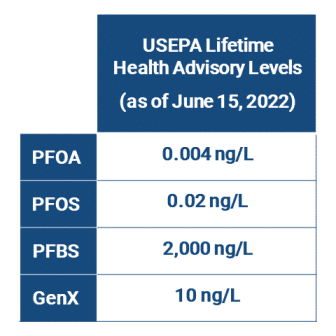PFAS – How Low Can You Go? Now We Know!
New Health Advisory Limits (HALs) for PFOA and PFOS in drinking water could be a game-changer.
By Scott Bell, Senior Environmental Engineer/Vice President (Ann Arbor, MI)
June 20, 2022
A little over two years ago, I wrote an article called “How Low Can You Go?”(1). I discussed the trend toward lower and lower treatment and cleanup standards for PFAS and the challenge presented to the regulated community when those numeric standards approach laboratory method detection limits. Well, on Wednesday, June 15, things got even more interesting.
So what happened? The USEPA announced new health advisory levels (HALs) for PFOA, PFOS, PFBS, and Gen-X (2). Yes, HALs for PFOA and PFOS were promulgated back in 2016, so that’s not news. For years, many regulatory agencies around the US have referred to the USEPA lifetime HALs for PFOS and PFOA (70 ng/l individually or combined) as the only numeric Federal guidance on acceptable concentrations of these compounds, even if they aren’t enforceable. But this most recent announcement was different and could be a game-changer.
Game-changer? Why? The announced HALs are significant and could shake things up mainly because of the revised HAL concentrations for PFOA and PFOS, which are both much lower than 1 ng/l, as shown in the table below. Moreover, the HALs are well below current method detection limits (MDLs) available from most, if not all, commercial laboratories for aqueous (water) samples. This means that any measurable concentration of PFOA or PFOS can be interpreted as exceeding the USEPA lifetime HAL. And from another angle, in the case of a non-detect result at current MDLs, the potential that a sample exceeds the new HALs cannot be ruled out. Also, let’s not forget that recent studies have found measurable concentrations of PFAS, including PFOA and PFOS, in rainfall (3).
Note: ng/L and parts per trillion (ppt) are equivalent where 1 ng/L = 1 ppt
Some might ask, “So what? These aren’t the same as drinking water maximum contaminant levels (MCLs). They’re not enforceable.” True, but although these HALs aren’t legally enforceable standards, they have been referenced in many circumstances as the only available Federal numeric guidance on PFAS in water, especially in states with no state-level numeric criteria promulgated. In some cases, regulated entities measuring these compounds in surface water or groundwater interpreted concentrations below the USEPA HALs as an indicator that action was not necessary or that maybe only continued monitoring was needed. That argument can no longer be made if PFOA or PFOS are measured above detection limits.
It’s foreseeable that politicians, environmental groups, and possibly the general public will likely begin demanding more action when PFOA and PFOS are detected, even where enforceable standards don’t exist. In addition to the near-term demands for action that we’re likely to see, the new HALs may foreshadow what’s to come for Federal drinking water standards for PFOA and PFOS, which is a stated goal in USEPA’s 2021 Strategic PFAS Roadmap (4), with a publication goal for a final rule by fall 2023. Granted, the setting of MCLs will require consideration of technical feasibility and economics, and not just health effects, but these HALs signal a leaning towards very low MCLs. And obviously, the potential goes beyond drinking water standards to groundwater cleanup criteria and/or numeric limits on surface water discharges. With human health advisory limits of essentially zero for PFOA and PFOS, what might those standards look like? USEPA has already started to downplay the implications of these new HALs for PFOA and PFOS, but for now, they seem like a game-changer.
If you have any questions about PFAS regulations or would like to discuss your PFAS-related needs, please feel free to contact me at sbell@limno.com.
This article is the tenth in a series of articles authored by LimnoTech staff on PFAS-related issues. Follow us on LinkedIn or Twitter (@LimnoTech), and check the Insights & Perspectives page on our website for more information and updates. Links to the other PFAS articles in this series are provided below:
Sampling for PFAS Requires Caution
PFAS Analysis – The New Wild West
Aviation and PFAS – What’s the Connection?
PFAS – The Next Wastewater Utility Challenge?
Should Municipalities Worry About PFAS?
Key Considerations for PFAS Field Investigations
Scott Bell, PE, is a Vice President and Senior Environmental Engineer at LimnoTech, where he has worked since 1992. In addition to managing staff and projects, Scott has technical expertise in subsurface investigation, environmental remediation and restoration, and engineering feasibility studies. He currently leads LimnoTech’s PFAS response efforts and supports industrial, legal, business, and civilian aviation clients across the country with their PFAS-related problems.






